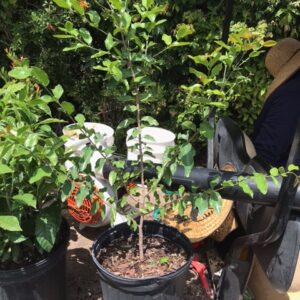General Landscape Uses: An excellent accent or specimen tree or large shrub in moist to wet locations, but it is intolerant of and will languish in drier soils.
Ecological Restoration Notes: A common element of wetland thickets and swamp margins.
Description: Small to medium or rarely a large tree with variable crowns composed of numerous branches. Trunks often short, branching near the ground, 6-12 inches in diameter. Bark whitish to grayish to almost black, often covered with numerous lichens and other epiphytes. Leaves flat, leathery 2-4 inches long, dark above, paler beneath.
Dimensions: Typically 10-30 feet in height; to 68 feet in South Florida. Usually taller than broad.
Growth Rate: Moderate to slow.
Range: Southeastern United States west to Texas and south to Miami Dade County and the Monroe County mainland; Bahamas, Cuba, Mexico and Central America.
Habitats: Swamps and moist forests.
Soils: Wet to moist, moderately well-drained to poorly-drained organic or sandy soils, often with acid pH.
Nutritional Requirements: High; requires rich organic soils for optimal growth.
Salt Water Tolerance: Low; does not tolerate long-term flooding by salt or brackish water.
Salt Wind Tolerance: Moderate; grows near salt water, but is protected from direct salt spray by other vegetation.
Drought Tolerance: Moderate to low; requires moist to wet soils, but tolerant of short periods of drought once established.
Light Requirements: Full sun to light shade.
Flower Color: Yellowish-white.
Flower Characteristics: Inconspicuous. Dioecious, with male and female flowers on separate plants.
Flowering Season: All year; peak in spring.
Fruit: A 1/4″ diameter drupe, usually red, sometimes yellow or orange. Mostly ripening in the fall. Edible but not tasty.
Wildlife and Ecology: Provides significant food and cover for wildlife. Deer browse the young growth. Attracts bee pollinators. Small mammals, turkey, quail, red-eyed vireos and a wide variety of other songbirds eat the fruits. The thick foliage provides excellent cover for small birds. It hosts a wide variety of insects and spiders, which, in turn, are eaten by many kinds of birds.
Horticultural Notes: Can be grown from de-pulped seed after the fruit is fully ripe. Clean and plant right away; the seeds do not store well. Plant in a container with at least 2″ of soil. Sprinkle soil to just cover the seeds. Place in partial shade. Also grown from cuttings, best treated with a rooting hormone.
Comments: This small tree is excellent for low spots in the garden. The red berries make an excellent holiday decoration.










Pam S. –
A beautiful native option.
Sheryl –
The flower is beautiful.